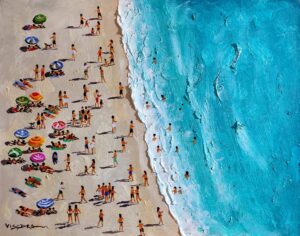Mark Bradford, a recipient of prestigious honors like the MacArthur Fellowship (commonly referred to as the “Genius Grant”), is celebrated for his transformative approach to art. His works weave together abstraction, cultural commentary, and material innovation, with Value 87 (2009) exemplifying his masterful ability to repurpose everyday materials into profound, multi-layered visual narratives. This piece not only reflects Bradford’s artistic vision but also showcases his intellectual approach to materiality and utility—two hallmarks of his practice.
Materiality in Value 87
At its core, Value 87 is an exploration of materiality. Bradford employs nontraditional art supplies, including billboard paper, newsprint, and other discarded ephemera, transforming them into textured, dynamic compositions. His process involves layering, scraping, and sanding these materials to reveal hidden depths and complexities.
Billboard Paper: A Cultural Artifact
Billboard paper is a recurring element in Bradford’s work, symbolizing the urban landscape from which he draws inspiration. In Value 87, the billboard paper’s vibrant hues and weathered textures create a raw, visceral connection to the city. These materials, often overlooked or discarded, carry the weight of public communication—advertisements, announcements, and societal messaging—imbuing the work with a layered social and historical narrative.
Mixed Media Layers: The Palimpsest Effect
Bradford’s use of mixed media creates a palimpsest-like effect, where layers of material obscure and reveal each other. This technique mirrors the way histories are written and rewritten over time, particularly in marginalized communities. The physicality of Value 87—its ridges, grooves, and carved patterns—demands close inspection, rewarding viewers with hidden details that emerge gradually.
Sanding and Carving: A Method of Excavation
Bradford’s process of sanding and carving into the layered materials is akin to archaeological excavation. By physically grinding away at the surface, he uncovers colors, shapes, and textures beneath. This act of removal is as significant as the act of layering; it speaks to the erasure and rediscovery of cultural and personal histories.
Utility and Transformation
The utility of everyday materials in Value 87 is a defining characteristic of Bradford’s practice. He repurposes items typically regarded as disposable, turning them into tools for storytelling and abstraction. This approach challenges traditional notions of what constitutes fine art and highlights the socio-political potential of material utility.
Democratization of Materials
Bradford’s choice of materials—billboard paper, newsprint, and other urban detritus—elevates the mundane to the monumental. This democratization of materials aligns with his broader thematic concerns, offering a counter-narrative to the exclusivity often associated with high art.
Embodied Urban Experience
The materials in Value 87 are intrinsically tied to urban life. By incorporating remnants of the cityscape, Bradford imbues the work with an embodied sense of place. The layers of paper and texture mirror the layered realities of urban environments, where histories overlap and intersect.
Commentary on Consumption and Waste
Bradford’s use of reclaimed materials also serves as a critique of consumer culture and waste. In Value 87, the reuse of billboard paper—a symbol of mass communication and consumerism—transforms the detritus of capitalism into a commentary on its excesses. This recontextualization forces viewers to confront the ways in which society discards not only materials but also stories and people.
Impression
Visually, Value 87 is a dynamic interplay of color, texture, and movement. The composition draws the viewer’s eye across the canvas, guided by ridges and channels created through Bradford’s carving and layering techniques. The result is a sense of controlled chaos, where the materials seem to vibrate with energy.
Dynamic Abstraction
The abstract forms in Value 87 resist easy interpretation, inviting viewers to project their own meanings onto the work. This ambiguity is a hallmark of Bradford’s style, allowing his pieces to function as both personal expressions and universal meditations on society.
Movement and Rhythm
The grooves and ridges carved into the surface of Value 87 create a rhythmic flow that mirrors the energy of the urban environment. The interplay of light and shadow across these textures adds depth and dynamism, making the piece feel alive and ever-changing.
Layered Symbolism
Each layer of Value 87 carries symbolic weight, from the billboard paper representing public discourse to the carved patterns evoking maps, graffiti, or even scars. This layered symbolism reflects Bradford’s interest in the intersections of identity, history, and place.
The Genius of Value 87
Bradford’s receipt of the MacArthur Fellowship in 2009, the same year Value 87 was created, underscores the intellectual rigor and cultural relevance of his work. The “Genius Grant” recognizes individuals who push the boundaries of their fields, and Bradford’s practice does just that by redefining the possibilities of abstraction and materiality.
A Socially Engaged Abstraction
Unlike many abstract artists, Bradford grounds his work in real-world concerns. Value 87 is not just an aesthetic achievement but also a socio-political statement. The materials, processes, and themes in the piece speak to issues of race, class, and the urban experience, making it a deeply engaged form of abstraction.
Bridging Fine Art and Everyday Life
Bradford’s ability to bridge the worlds of fine art and everyday life is a testament to his ingenuity. In Value 87, he transforms the detritus of the city into a masterpiece, challenging viewers to see beauty and meaning in the overlooked and discarded.
An Ongoing Dialogue
Value 87 exemplifies Bradford’s commitment to creating art that sparks dialogue. The work invites viewers to question their assumptions about materials, abstraction, and the stories embedded in the urban landscape. This open-endedness is a key aspect of Bradford’s genius, allowing his work to remain relevant and resonant across time and contexts.
Value 87 as a Reflection of Bradford’s Brilliance
Mark Bradford’s Value 87 (2009) is a masterclass in the power of materiality and utility to convey complex narratives. Through his innovative use of billboard paper, mixed media, and transformative techniques, Bradford creates a work that is as intellectually rich as it is visually striking.
The piece encapsulates the themes that define Bradford’s career: the intersection of the personal and the political, the beauty of the discarded, and the resilience of marginalized voices. As a recipient of the MacArthur Fellowship, Bradford continues to demonstrate how art can be a vehicle for change, pushing boundaries and inspiring new ways of seeing the world.
In Value 87, Bradford reminds us that even the most ordinary materials can hold extraordinary meaning, transforming the canvas into a space where history, identity, and imagination converge. This piece not only reflects his genius but also challenges us to consider the value of what we so often overlook.
No comments yet.








